L.C. Clark's Blog
February 8, 2019
Blog’s 6th Anniversary
I celebrate the blog's anniversary every February. A blog can’t be just a collection of researched data or information. It must contain personal perspective on events, opinion on current issues or a fresh take on an old school of thought. People blog about what’s significant to them, food for those who cook, lifestyle for the fashionable, networking for business or literary training.
I blog because I believe my opinion is valid, based on my life experiences. My spheres of influence (SOI) are Jehovah’s Witnesses, dialysis patients, the Filipino in the Philippines and the Filipino in the United States. I am all of the above and more.
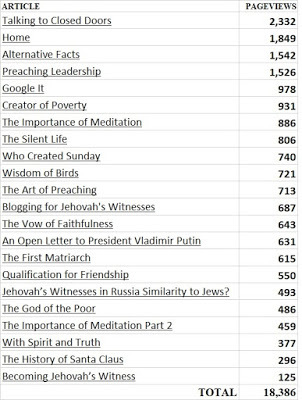 As Jehovah’s Witness, the Bible articles have been viewed 18,386 times. That number is nothing to brag about considering the internet can deliver millions but as part of my ministry, I will never find that number of people by going door to door even if we add my cart witnessing or street witnessing.
As Jehovah’s Witness, the Bible articles have been viewed 18,386 times. That number is nothing to brag about considering the internet can deliver millions but as part of my ministry, I will never find that number of people by going door to door even if we add my cart witnessing or street witnessing.
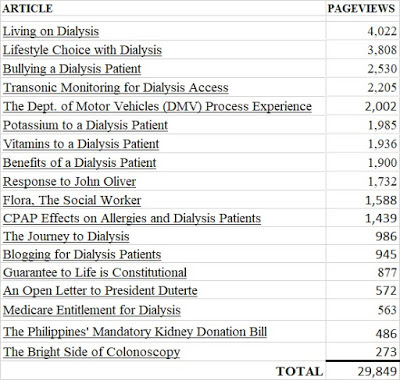 As a dialysis patient, posts on the illness and treatment have been viewed 29,849 times. If the posts helped just one patient, the work is well worth it.
As a dialysis patient, posts on the illness and treatment have been viewed 29,849 times. If the posts helped just one patient, the work is well worth it.
As a Filipino in the Philippines and US, featured posts are on the lower right side of the page. Does blogging pay? Answer: Not a dime. However, it has given me a voice that reaches countries I will never, in this lifetime, be able to visit. See also:A Milestone
See also:A Milestone
I blog because I believe my opinion is valid, based on my life experiences. My spheres of influence (SOI) are Jehovah’s Witnesses, dialysis patients, the Filipino in the Philippines and the Filipino in the United States. I am all of the above and more.
 As Jehovah’s Witness, the Bible articles have been viewed 18,386 times. That number is nothing to brag about considering the internet can deliver millions but as part of my ministry, I will never find that number of people by going door to door even if we add my cart witnessing or street witnessing.
As Jehovah’s Witness, the Bible articles have been viewed 18,386 times. That number is nothing to brag about considering the internet can deliver millions but as part of my ministry, I will never find that number of people by going door to door even if we add my cart witnessing or street witnessing. As a dialysis patient, posts on the illness and treatment have been viewed 29,849 times. If the posts helped just one patient, the work is well worth it.
As a dialysis patient, posts on the illness and treatment have been viewed 29,849 times. If the posts helped just one patient, the work is well worth it.As a Filipino in the Philippines and US, featured posts are on the lower right side of the page. Does blogging pay? Answer: Not a dime. However, it has given me a voice that reaches countries I will never, in this lifetime, be able to visit.
 See also:A Milestone
See also:A Milestone
Published on February 08, 2019 13:31
February 1, 2019
Vandalism is an Attack
I belonged to an American community in Kentucky for seven years. Underlying racism against me was manifested in more ways than one. I was a little, fresh off the boat, Asian who drove a sporty red
“Look! She’s going 60 along Broadway,” one of the ladies in my car said, apparently observing my driving.
“What’s wrong with that?” I asked.
“Duh! You don’t read the speed limit?!” She replied and pointed to me one that says 35. We all laughed.
During those years, friend or foe, no one took a step to vandalize Slick.
In the Philippines, for years, I drove for acquaintances I met in urban poor areas. Some were a shower away from looking homeless. Some of those were uneducated. Some were on the run from criminal record. I never charged for the ride. It was endearing to see them be very careful not to make a mess in my car. I saw one or two wipe off a smear they didn’t create, in gratitude for the free rides. Once in while I got an offer to wash my car that I always declined. I wanted them to see me as a friend, not a benefactor. One of them, a woman, was observing my driving and admiringly said “Look! She just made a U-Turn going 60 without stepping on the brakes!” I did not even know that was wrong. I liked that it make me look cool without trying.
Here in California, for five years, I drove Filipina associates who didn’t have a car. As my usual, the ride is free. One difference is that every ride is a driving test. My riders here keep criticizing my driving worse than a cop on duty, as if they’re expert drivers even if they never drove. They speak to me like I’m a thirteen year old student driver. I’ve been driving for forty years, since I was twenty six years old.
One of my Filipina frequent free riders developed a controlling attitude. When we were shopping, she questioned my spending like it was her money saying, “Didn’t you just buy one of those recently? Why are you buying again?” She kept giving me directions even when I knew perfectly well where we were going, even to places I had driven to, so many times. I should have seen red flags when she said, “Why don’t you associate with an American group?” She was trying to get rid of me. I didn’t get the message, so she did this behind my back, while I was driving.
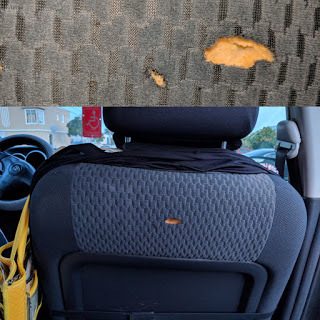
See also:Keying In A Filipina's View of Rural Kentucky Memory is Selective
“Look! She’s going 60 along Broadway,” one of the ladies in my car said, apparently observing my driving.
“What’s wrong with that?” I asked.
“Duh! You don’t read the speed limit?!” She replied and pointed to me one that says 35. We all laughed.
During those years, friend or foe, no one took a step to vandalize Slick.
In the Philippines, for years, I drove for acquaintances I met in urban poor areas. Some were a shower away from looking homeless. Some of those were uneducated. Some were on the run from criminal record. I never charged for the ride. It was endearing to see them be very careful not to make a mess in my car. I saw one or two wipe off a smear they didn’t create, in gratitude for the free rides. Once in while I got an offer to wash my car that I always declined. I wanted them to see me as a friend, not a benefactor. One of them, a woman, was observing my driving and admiringly said “Look! She just made a U-Turn going 60 without stepping on the brakes!” I did not even know that was wrong. I liked that it make me look cool without trying.
Here in California, for five years, I drove Filipina associates who didn’t have a car. As my usual, the ride is free. One difference is that every ride is a driving test. My riders here keep criticizing my driving worse than a cop on duty, as if they’re expert drivers even if they never drove. They speak to me like I’m a thirteen year old student driver. I’ve been driving for forty years, since I was twenty six years old.
One of my Filipina frequent free riders developed a controlling attitude. When we were shopping, she questioned my spending like it was her money saying, “Didn’t you just buy one of those recently? Why are you buying again?” She kept giving me directions even when I knew perfectly well where we were going, even to places I had driven to, so many times. I should have seen red flags when she said, “Why don’t you associate with an American group?” She was trying to get rid of me. I didn’t get the message, so she did this behind my back, while I was driving.

See also:Keying In A Filipina's View of Rural Kentucky Memory is Selective
Published on February 01, 2019 07:58
January 23, 2019
Becoming Jehovah’s Witness
 Every Jehovah’s Witness has a story to tell how they came to know, worship and serve Jehovah. Here’s my story.
Every Jehovah’s Witness has a story to tell how they came to know, worship and serve Jehovah. Here’s my story.My family and I were Mormons for thirteen years. That started when Mormon missionaries knocked on our door holding the Bible. After a few visits we were discussing the Book of Mormon not the Bible. Soon enough we were attending their Sunday services, then baptized, then paying tithe. I will be writing a book about those thirteen years, for now I want to narrate how I escaped.
We moved to Imus, Cavite and there Jehovah’s Witnesses came to our door. It was before Google so I thought Jehovah, a foreign name like Buddha or Krishna, is not related to Jesus Christ. I reacted to the JWs with antagonism. One of the ladies, Jane lived at the top of my street. They continued to come around intermittently. I responded to them the same way every time, arrogant that I’m a Bible carrier on Sundays and a tithe payer, albeit begrudgingly.
I was working as Marketing Director for a waterproofing company. My clients were banks and factories with buildings that needed rewaterproofing due to the annual months of typhoon in the Philippines. Needless to say, my clients and I discussed rain a lot. One day, one of my clients, said, “Did you know that it didn’t rain on this earth before Noah’s flood?”
“No, it rained. Just as it is here in the Philippines, it rains and it doesn’t always flood,” I replied.
“People were laughing at Noah when he preached it would flood because it didn’t rain,” he insisted.
“That’s impossible. Vegetation will die without rain,” I counter insisted.
My client then reached under his desk. He whipped out a Bible, turned the pages and showed me this, “because Jehovah God had not made it rain on the earth and there was no man to cultivate the ground. But a mist would go up from the earth, and it watered the entire surface of the ground.” (Genesis 2:5-6)
I was dumbfounded! Thirteen years of holding the Bible and attending Sunday services yet something as basic as Noah’s flood was not discussed. I asked my client, “What’s your religion?”
“I’m a Jehovah’s Witness.”
“Hey, they come to the house once in a while. I scare them away,” I said laughing.
“Oh no, they’re good people. Talk to them, let them in next time.”
The next time Jane, the same lady I used to drive away came around I said, “Come inside, let’s talk.”
That was a start. I accepted a Bible study with Jane. I was baptized in 1991, at the Lovers of Freedom Convention held in Cavite, Philippines. When I saw the title of the convention, I knew Jehovah has provided me escape in more ways than one. (2 Samuel 22:1-8)
See also:Blogging for Jehovah's Witnesses The Unbiblical Noah Movie DNA, Wine and Injustice
Published on January 23, 2019 09:33
January 11, 2019
The Bragging Rights
In the Philippines, when you apply for a job, you will need a diploma and transcript of records from the university that issued the diploma. That’s because diplomas are easily faked. There’s a street called Recto Avenue which is termed as “diploma mill”. You will find numerous street vendors selling diploma falsification services. If you want one that should have been issued decades back, it can be arranged. The paper is soaked in tea to make it look brownish antiquated prior to printing. Lately a transcript of records with shining grades from any university is also available for sale. What does this serve, you might ask? Answer: Bragging rights!
In Kentucky, I met a Filipina who claimed she’s a graduate of Lyceum of the Philippines University. Her only job in America was serving at McDonalds.
I met another one here in California, who brandished multiple diplomas for several college degrees such as Nursing, UP College of Law, etc. She even showed me the antique looking laminated diplomas on her wall. I was curious about the employment history. I was told by someone else that she was “stocking shelves in Walgreens” until fired.
Another bragging right for Filipinos is money, whether they have it or not. I once asked an associate if he also gets “brown bag”, a benefit of free groceries for seniors. He replied “Oh, I’m not qualified. I have a lot of money in the bank!”
Last week I was overheard saying, “I’m broke but happy.” I got mixed reactions. One who drives a crappy car and lives in a place worse than mine offered to lend me money saying she has $5000 laying around at home. I declined. Another response to my “broke” comment came from a wealthy associate. Out of the kindness of her heart, she gave me a rotten vegetable. I thanked her sincerely. When I showed it to my friend who’s also a dialysis patient, my friend said “Where do you find these people?!”
Another response to my “broke” comment came from a wealthy associate. Out of the kindness of her heart, she gave me a rotten vegetable. I thanked her sincerely. When I showed it to my friend who’s also a dialysis patient, my friend said “Where do you find these people?!”
 My dining table I get social security monthly, so technically, I’m not broke. I drive an old car but miles away from crappy. I live in a nice enough two bedroom unit with my daughter. I have written two books published in Amazon. I have a blog and YouTube channel. I hardly ever speak about my place, my car or my books.
My dining table I get social security monthly, so technically, I’m not broke. I drive an old car but miles away from crappy. I live in a nice enough two bedroom unit with my daughter. I have written two books published in Amazon. I have a blog and YouTube channel. I hardly ever speak about my place, my car or my books.
 My bedroom
My bedroom
My only bragging right is I married three times. The first one looks like Jason Momoa, the second looks like Joey Marquez, the third, an American looks like Matthew McConaughey. Not bad for one lifetime, not bad at all.
See also:Memory is Selective Souvenirs of the Third Man Dropout and Proud, The Autodidactic Polymath
In Kentucky, I met a Filipina who claimed she’s a graduate of Lyceum of the Philippines University. Her only job in America was serving at McDonalds.
I met another one here in California, who brandished multiple diplomas for several college degrees such as Nursing, UP College of Law, etc. She even showed me the antique looking laminated diplomas on her wall. I was curious about the employment history. I was told by someone else that she was “stocking shelves in Walgreens” until fired.
Another bragging right for Filipinos is money, whether they have it or not. I once asked an associate if he also gets “brown bag”, a benefit of free groceries for seniors. He replied “Oh, I’m not qualified. I have a lot of money in the bank!”
Last week I was overheard saying, “I’m broke but happy.” I got mixed reactions. One who drives a crappy car and lives in a place worse than mine offered to lend me money saying she has $5000 laying around at home. I declined.
 Another response to my “broke” comment came from a wealthy associate. Out of the kindness of her heart, she gave me a rotten vegetable. I thanked her sincerely. When I showed it to my friend who’s also a dialysis patient, my friend said “Where do you find these people?!”
Another response to my “broke” comment came from a wealthy associate. Out of the kindness of her heart, she gave me a rotten vegetable. I thanked her sincerely. When I showed it to my friend who’s also a dialysis patient, my friend said “Where do you find these people?!” My dining table I get social security monthly, so technically, I’m not broke. I drive an old car but miles away from crappy. I live in a nice enough two bedroom unit with my daughter. I have written two books published in Amazon. I have a blog and YouTube channel. I hardly ever speak about my place, my car or my books.
My dining table I get social security monthly, so technically, I’m not broke. I drive an old car but miles away from crappy. I live in a nice enough two bedroom unit with my daughter. I have written two books published in Amazon. I have a blog and YouTube channel. I hardly ever speak about my place, my car or my books.  My bedroom
My bedroomMy only bragging right is I married three times. The first one looks like Jason Momoa, the second looks like Joey Marquez, the third, an American looks like Matthew McConaughey. Not bad for one lifetime, not bad at all.
See also:Memory is Selective Souvenirs of the Third Man Dropout and Proud, The Autodidactic Polymath
Published on January 11, 2019 16:29
January 6, 2019
Costco for the Thrifty
The Costco Wholesale Store has a membership fee. That makes one hesitate to consider shopping there. If you belong to a small family, you might think, why buy at a wholesale store? We are two in the family so I took three years to decide. Now I’m glad I did. Here are the items where I ended up saving.
 I have been on dialysis for 8 years and I still I consume a truck load of soda a year. I just make sure I take my phosphorus binder pill every time. A big box of Pepsi cost me $.30 cents per can.
I have been on dialysis for 8 years and I still I consume a truck load of soda a year. I just make sure I take my phosphorus binder pill every time. A big box of Pepsi cost me $.30 cents per can.
A bag of romaine lettuce with 6 in it cost me about $.50 cents each.
 My arm where my dialysis access is installed has become sensitive. To make sure it doesn’t clog with blood clot, I had to get rid of my old jackets that are perfectly fit. Now I need one or two sizes bigger. Jackets are at the least over $20. Costco has a jacket that sells for $13.00, that is warm, light weight and made of fabric like a shirt so I don’t look too cold. When on dialysis, you’re always cold but I still don’t want to look it. I loved the jacket so much I bought 3 of them.
My arm where my dialysis access is installed has become sensitive. To make sure it doesn’t clog with blood clot, I had to get rid of my old jackets that are perfectly fit. Now I need one or two sizes bigger. Jackets are at the least over $20. Costco has a jacket that sells for $13.00, that is warm, light weight and made of fabric like a shirt so I don’t look too cold. When on dialysis, you’re always cold but I still don’t want to look it. I loved the jacket so much I bought 3 of them.
The rotisserie chicken is the best in the market. The chicken if perfectly drained of blood in preparation. You won’t find meat darkened with cooked leftover blood. It only cost $5. For a big one. I can make 3 dishes out of it and then some. Even the bones after I have removed the meat is good for chicken broth you can use for chicken soup. Below is a video of suggested dishes. Here are the recipes how I make them.
Pancit Canton
Lucky Me Canton or any Instant Mami, any Instant noodle
Chopped chicken meatChopped lettuceShredded carrots Chicken Salad
Pineapple in canShredded carrotsChopped chicken meatRaisins Miracle Whip (no sugar, no other flavoring) Chicken Alfredo
Alfredo Sauce in bottle or the Knorr Alfredo sauce mix
Chopped chicken meat Chopped Broccoli or Celery
My vitamins are cheaper from Costco and I take a lot of vitamins. The dialysis machine cleans out the nutrients from the food so that goes down the drain. I decided on my own but with my doctor’s consent to take the particular vitamins I need. Vitamins B6 and B12, Vitamin C, Fish Oil, Vitamin E, Calcium and Biotin for the hair, because most dialysis patients lose hair prematurely.
See also:More Thrift Tips If You are Out of... Mediterranean Spaghetti
 I have been on dialysis for 8 years and I still I consume a truck load of soda a year. I just make sure I take my phosphorus binder pill every time. A big box of Pepsi cost me $.30 cents per can.
I have been on dialysis for 8 years and I still I consume a truck load of soda a year. I just make sure I take my phosphorus binder pill every time. A big box of Pepsi cost me $.30 cents per can.A bag of romaine lettuce with 6 in it cost me about $.50 cents each.
 My arm where my dialysis access is installed has become sensitive. To make sure it doesn’t clog with blood clot, I had to get rid of my old jackets that are perfectly fit. Now I need one or two sizes bigger. Jackets are at the least over $20. Costco has a jacket that sells for $13.00, that is warm, light weight and made of fabric like a shirt so I don’t look too cold. When on dialysis, you’re always cold but I still don’t want to look it. I loved the jacket so much I bought 3 of them.
My arm where my dialysis access is installed has become sensitive. To make sure it doesn’t clog with blood clot, I had to get rid of my old jackets that are perfectly fit. Now I need one or two sizes bigger. Jackets are at the least over $20. Costco has a jacket that sells for $13.00, that is warm, light weight and made of fabric like a shirt so I don’t look too cold. When on dialysis, you’re always cold but I still don’t want to look it. I loved the jacket so much I bought 3 of them.The rotisserie chicken is the best in the market. The chicken if perfectly drained of blood in preparation. You won’t find meat darkened with cooked leftover blood. It only cost $5. For a big one. I can make 3 dishes out of it and then some. Even the bones after I have removed the meat is good for chicken broth you can use for chicken soup. Below is a video of suggested dishes. Here are the recipes how I make them.
Pancit Canton
Lucky Me Canton or any Instant Mami, any Instant noodle
Chopped chicken meatChopped lettuceShredded carrots Chicken Salad
Pineapple in canShredded carrotsChopped chicken meatRaisins Miracle Whip (no sugar, no other flavoring) Chicken Alfredo
Alfredo Sauce in bottle or the Knorr Alfredo sauce mix
Chopped chicken meat Chopped Broccoli or Celery
My vitamins are cheaper from Costco and I take a lot of vitamins. The dialysis machine cleans out the nutrients from the food so that goes down the drain. I decided on my own but with my doctor’s consent to take the particular vitamins I need. Vitamins B6 and B12, Vitamin C, Fish Oil, Vitamin E, Calcium and Biotin for the hair, because most dialysis patients lose hair prematurely.
See also:More Thrift Tips If You are Out of... Mediterranean Spaghetti
Published on January 06, 2019 09:46
December 30, 2018
The Dangers of Cart Witnessing in California
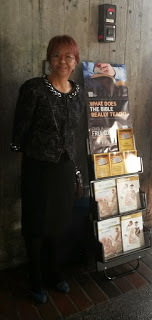 Literature display tables and carts is only one of the ways Jehovah’s Witnesses preach the good news of God’s Kingdom. The program started in 2014. I started Cart Witnessing as soon as a cart became available in my congregation. The spot I picked is the Daly City BART station. Like any public place, Daly City BART station has its share of homeless and psychologically challenged poor. That was exactly what brought me to Cart Witnessing.
Literature display tables and carts is only one of the ways Jehovah’s Witnesses preach the good news of God’s Kingdom. The program started in 2014. I started Cart Witnessing as soon as a cart became available in my congregation. The spot I picked is the Daly City BART station. Like any public place, Daly City BART station has its share of homeless and psychologically challenged poor. That was exactly what brought me to Cart Witnessing.In my youth, I visited slum areas and peasant communities in the Philippines as part of a student outreach program. From there, the poor has sunk into a soft part of my heart. I knew that going door to door with the Bible message did not reach people who didn’t have doors. In the Philippines Jehovah’s Witnesses approached people who lived in cardboard boxes or make shift sidewalk placements. In America, the Cart Witnessing is providing the Bible message to the homeless and carless, overworked laborers working two to three jobs, so that they’re never home when we knock.
In the beginning brothers came with the sisters. The elders were wary that sisters, left without a brother, could be harassed by evil strangers. Back then, I was told that the organization rule was to have at least one brother for every cart. Eventually, sisters were allowed to do cart without a brother.
True enough, I experienced some forms of harassment. Strangers who were fanatics in their chosen religion, who were not used to seeing the newly instituted Cart Witnessing, screamed expletives at us. Some took literature pretending to be interested in Bible truth then tore and threw the literature in the nearest trash. We were given instruction not to debate with anyone. We were warned to be careful and alert but not to engage to escalate such encounters.
Once, an American man, who did not look poor just angry for some reason, screamed curses at us. I followed him with my eyes. He went over to stand right behind me. His plan must have been to attack me behind my back. That’s what criminals do so they can’t be identified. I turned around to face him with him a few inches from me. He was tall. I’m a small Asian. The sick thing was, I wasn’t scared. I stared up at his face continuously until, frustrated, he walked away. I felt triumphant!
Las week, someone took a book from the cart. I told my companion I will go for a minute to get another book from my car in the parking lot. When I returned, the sister told me a man went to the cart and when she approached, he put his arms on her shoulder. The sister was terrified. I told her I will never leave her alone again even for a minute. I was afraid the incident might turn the sister off Cart Witnessing.
That sister and I continue to do Cart Witnessing on the same spot to this date.
See also:Statistics from the HeartThe Art of Preaching Wisdom of Birds
Published on December 30, 2018 09:47
December 15, 2018
The Journey to Dialysis
In the winter of 2009, I began to have agonizing leg cramps in the evenings. I thought it was caused by the high heeled shoes I wore to work. I was working as Executive Assistant for a bank and the lady executive I was assisting insisted that I wear suits daily except on casual Fridays. Suits don’t match with flats. Other than the cramps, I felt great.
In April of the same year, I got excruciating stomach pain. I thought it was cancer. I went to a doctor to confirm. It was my first time to get sick in America so the doctor I went to, Dr. Russell T. May, was a perfect stranger. He prescribed antibiotics. I was back to work in a week.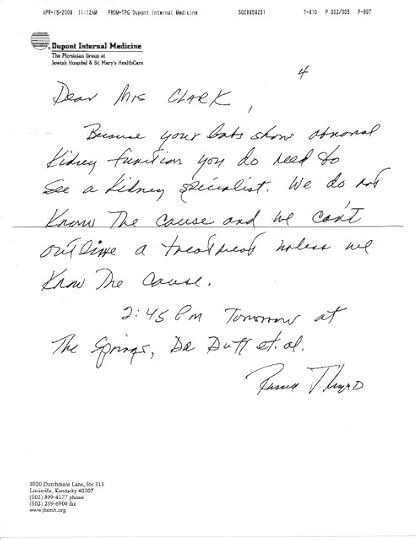
Then, I received a letter from Dr. May. The letter was hand written. That means the content was so confidential that he didn’t have his assistant type it. It says, he’s referring me to a kidney specialist. He wrote, “We do not know the cause”, underlined for emphasis because I didn't have any other medical condition that could lead to CKD. An appointment has already been set for me to see Dr. Nizar M. Attallah.
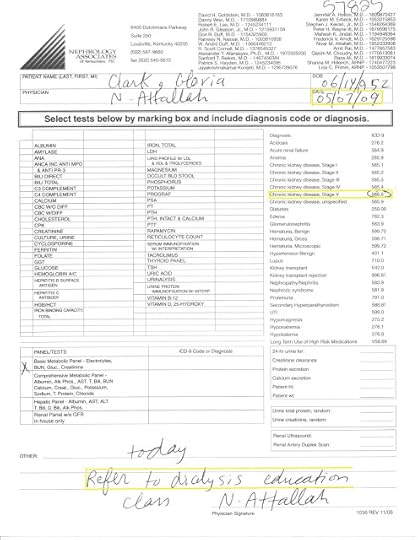 The diagnosis form dated May 7, 2009, says “Stage V” Chronic Kidney Disease. I was already at Stage V!!! What happened to Stage I – IV? That means, as a Filipino saying goes, “I had one foot in my grave.” If Dr. May had not sent me to Dr. Attallah I would have died in probably less than a year. I owe my life to those doctors and to my God Jehovah, who made sure I live to continue my journey of a hundred lives.
The diagnosis form dated May 7, 2009, says “Stage V” Chronic Kidney Disease. I was already at Stage V!!! What happened to Stage I – IV? That means, as a Filipino saying goes, “I had one foot in my grave.” If Dr. May had not sent me to Dr. Attallah I would have died in probably less than a year. I owe my life to those doctors and to my God Jehovah, who made sure I live to continue my journey of a hundred lives.
I was referred by Dr. Attallah to dialysis education. I was placed in a room to watch a video presentation of different kinds of dialysis so I can make an informed decision which one would suit my lifestyle. I, right up, rejected peritoneal dialysis or any kind of home dialysis.
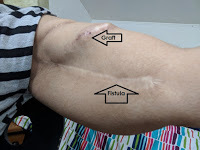 What followed was a series of medical procedures. My vascular surgeon, Dr. Lambert, first installed a fistula on my upper arm. The scar went all the way down to my elbow. That fistula was abandoned. The vein refused to grow wide enough for dialysis. He installed a graft. On August 26, 2010, fifteen months from the time I was diagnosed, I started hemodialysis at the University of Louisville Kidney Disease Program, Louisville, Kentucky. I am now with DaVita, in California.
What followed was a series of medical procedures. My vascular surgeon, Dr. Lambert, first installed a fistula on my upper arm. The scar went all the way down to my elbow. That fistula was abandoned. The vein refused to grow wide enough for dialysis. He installed a graft. On August 26, 2010, fifteen months from the time I was diagnosed, I started hemodialysis at the University of Louisville Kidney Disease Program, Louisville, Kentucky. I am now with DaVita, in California.
See also:
Blog’s 4th Anniversary
Paperback Writer - REBEL
Paperback Writer
In April of the same year, I got excruciating stomach pain. I thought it was cancer. I went to a doctor to confirm. It was my first time to get sick in America so the doctor I went to, Dr. Russell T. May, was a perfect stranger. He prescribed antibiotics. I was back to work in a week.

Then, I received a letter from Dr. May. The letter was hand written. That means the content was so confidential that he didn’t have his assistant type it. It says, he’s referring me to a kidney specialist. He wrote, “We do not know the cause”, underlined for emphasis because I didn't have any other medical condition that could lead to CKD. An appointment has already been set for me to see Dr. Nizar M. Attallah.
 The diagnosis form dated May 7, 2009, says “Stage V” Chronic Kidney Disease. I was already at Stage V!!! What happened to Stage I – IV? That means, as a Filipino saying goes, “I had one foot in my grave.” If Dr. May had not sent me to Dr. Attallah I would have died in probably less than a year. I owe my life to those doctors and to my God Jehovah, who made sure I live to continue my journey of a hundred lives.
The diagnosis form dated May 7, 2009, says “Stage V” Chronic Kidney Disease. I was already at Stage V!!! What happened to Stage I – IV? That means, as a Filipino saying goes, “I had one foot in my grave.” If Dr. May had not sent me to Dr. Attallah I would have died in probably less than a year. I owe my life to those doctors and to my God Jehovah, who made sure I live to continue my journey of a hundred lives.I was referred by Dr. Attallah to dialysis education. I was placed in a room to watch a video presentation of different kinds of dialysis so I can make an informed decision which one would suit my lifestyle. I, right up, rejected peritoneal dialysis or any kind of home dialysis.
 What followed was a series of medical procedures. My vascular surgeon, Dr. Lambert, first installed a fistula on my upper arm. The scar went all the way down to my elbow. That fistula was abandoned. The vein refused to grow wide enough for dialysis. He installed a graft. On August 26, 2010, fifteen months from the time I was diagnosed, I started hemodialysis at the University of Louisville Kidney Disease Program, Louisville, Kentucky. I am now with DaVita, in California.
What followed was a series of medical procedures. My vascular surgeon, Dr. Lambert, first installed a fistula on my upper arm. The scar went all the way down to my elbow. That fistula was abandoned. The vein refused to grow wide enough for dialysis. He installed a graft. On August 26, 2010, fifteen months from the time I was diagnosed, I started hemodialysis at the University of Louisville Kidney Disease Program, Louisville, Kentucky. I am now with DaVita, in California.See also:
Blog’s 4th Anniversary
Paperback Writer - REBEL
Paperback Writer
Published on December 15, 2018 00:05
December 10, 2018
The History of Santa Claus
 The name Old Nick originated from Saint Nicholas, the bishop of Myra. For several hundred years, circa 1200 to 1500, St. Nicholas' legend took on some aspects of pagan deities, like the Roman Saturn or the Norse Odin, who appeared as white-bearded man and had magical powers like flight. Does that sound familiar?
The name Old Nick originated from Saint Nicholas, the bishop of Myra. For several hundred years, circa 1200 to 1500, St. Nicholas' legend took on some aspects of pagan deities, like the Roman Saturn or the Norse Odin, who appeared as white-bearded man and had magical powers like flight. Does that sound familiar? After the Protestant Reformation in the 1500s, some saints including Nicholas were disenfranchised. Later, the Germans created figures based on Nicholas, not as a saint but as a threatening Ru-klaus (Rough Nicholas), Aschenklas (Ashy Nicholas), and Pelznickel (Furry Nicholas) who expected good behavior from children or suffer consequences like whippings or kidnappings. Does that sound familiar?
In Catholicism, St. Nicholas was assigned to be the patron saint of children. However, his alter-ego punished bad children by whacking, stuffing them in a sack to take them away. Parts of Germany and Austria called that alter-ego Krampus who carried whips to beat children. Krampus was created as a counterpart to kindly St. Nicholas, who rewarded children with sweets. Krampus, in contrast, would swat wicked children, stuff them in a sack, and take them away to his lair.
Krampus is said to come from Norse mythology, the son of Hel, legendary beast who shares characteristics with other demonic creatures in Greek mythology. Later, the Catholic Church forbade celebrating Krampus, not because it was pagan or devilish, but because the World War II fascists an ally of the Catholic Church “found Krampus despicable…creation of the Social Democrats.”
In 1821 an anonymous poet shaped the modern Santa, associating him with Christmas by adding the magical gift-bringing of St. Nicholas. That figure brought gifts to good girls and boys, but also had a birch rod for corporal punishment typically used on the child’s buttocks, back and/or shoulders. Santa's wagon, back then was pulled by a single reindeer. In 1822 Clement Clarke Moore wrote published anonymously the next year, describer the “jolly Santa … rides a sleigh driven by eight familiar reindeer.”
In the late 19th century, the image of Santa became dressed in red with white fur trim, venturing out from the North Pole in a reindeer-driven sleigh but still keeping an eye on children's behavior. “The jolly, chubby, grandfatherly face of this Santa was largely created by Thomas Nast, the great political cartoonist.”
Saint Nicholas does not appear in the Bible. Krampus is a pagan creature. Clement Clarke Moore is not a writer in the Bible. Thomas Nast is a cartoonist not religious. Thus, the Merriam-Webster dictionary defines Old Nick as a name of the devil, synonyms are archfiend, Beelzebub, devil, fiend, Lucifer, Satan, serpent.
See also:Alternative Facts With Spirit and Truth The Art of Preaching
Published on December 10, 2018 11:10
Is Santa Claus Christian?
 The name Old Nick originated from Saint Nicholas, the bishop of Myra. For several hundred years, circa 1200 to 1500, St. Nicholas' legend took on some aspects of pagan deities, like the Roman Saturn or the Norse Odin, who appeared as white-bearded man and had magical powers like flight. Does that sound familiar?
The name Old Nick originated from Saint Nicholas, the bishop of Myra. For several hundred years, circa 1200 to 1500, St. Nicholas' legend took on some aspects of pagan deities, like the Roman Saturn or the Norse Odin, who appeared as white-bearded man and had magical powers like flight. Does that sound familiar? After the Protestant Reformation in the 1500s, some saints including Nicholas were disenfranchised. Later, the Germans created figures based on Nicholas, not as a saint but as a threatening Ru-klaus (Rough Nicholas), Aschenklas (Ashy Nicholas), and Pelznickel (Furry Nicholas) who expected good behavior from children or suffer consequences like whippings or kidnappings. Does that sound familiar?
In Catholicism, St. Nicholas was assigned to be the patron saint of children. However, his alter-ego punished bad children by whacking, stuffing them in a sack to take them away. Parts of Germany and Austria called that alter-ego Krampus who carried whips to beat children. Krampus was created as a counterpart to kindly St. Nicholas, who rewarded children with sweets. Krampus, in contrast, would swat wicked children, stuff them in a sack, and take them away to his lair.
Krampus is said to come from Norse mythology, the son of Hel, legendary beast who shares characteristics with other demonic creatures in Greek mythology. Later, the Catholic Church forbade celebrating Krampus, not because it was pagan or devilish, but because the World War II fascists an ally of the Catholic Church “found Krampus despicable…creation of the Social Democrats.”
In 1821 an anonymous poet shaped the modern Santa, associating him with Christmas by adding the magical gift-bringing of St. Nicholas. That figure brought gifts to good girls and boys, but also had a birch rod for corporal punishment typically used on the child’s buttocks, back and/or shoulders. Santa's wagon, back then was pulled by a single reindeer. In 1822 Clement Clarke Moore wrote published anonymously the next year, describer the “jolly Santa … rides a sleigh driven by eight familiar reindeer.”
In the late 19th century, the image of Santa became dressed in red with white fur trim, venturing out from the North Pole in a reindeer-driven sleigh but still keeping an eye on children's behavior. “The jolly, chubby, grandfatherly face of this Santa was largely created by Thomas Nast, the great political cartoonist.”
Saint Nicholas does not appear in the Bible. Krampus is a pagan creature. Clement Clarke Moore is not a writer in the Bible. Thomas Nast is a cartoonist not religious. Thus, the Merriam-Webster dictionary defines Old Nick as a name of the devil, synonyms are archfiend, Beelzebub, devil, fiend, Lucifer, Satan, serpent.
See also:Alternative Facts With Spirit and Truth The Art of Preaching
Published on December 10, 2018 11:10
November 19, 2018
The Philippines' Mandatory Kidney Donation Bill
In 2008, The New York Times published:
“MANILA — The Philippines is banning kidney transplants for foreigners, as part of a government crackdown on a growing but illicit trade in human organs bought from the poor, officials said Tuesday.
The ban is expected to take effect next month. Foreigners who violate it, as well as middlemen in the transaction, can be jailed for up to 20 years and fined as much as two million pesos, or about $48,000, the health secretary, Francisco T. Duque III, said at a news conference…
…Given the risks involved in undergoing nephrectomy and the lack of benefits arising from the procedure to donors, the dead should be the first to put their kidneys on the line.”
In the Philippines, living donors are rare precisely because of the risk to donors. The kidney patients refuse to pass on to their ‘family donor’ a future kidney failure or surgery complications and infection. It does make sense that kidneys should come from the deceased.
However, religious superstition prevents the family of the deceased to approve the organ donation from their dead. Centuries of non-Biblical doctrines spread by false preachers claimed that the dead can feel offense after death. While the Bible indisputably states “the dead know nothing at all… their love and their hate and their jealousy have already perished, and they no longer have any share in what is done under the sun.” (Ecclesiastes 9:5-6)
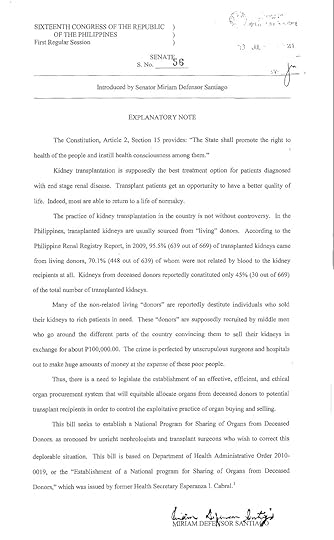 In 2013, Miriam Defensor Santiago filed the “Deceased Organ Donor Act” to promote the “deceased donor program in providing valuable treatment to those with kidney failure as well as in protecting the vulnerable sectors of society from the potential for abuse of living organ donors”. Her bill was to provide organs from deceased donors to potential transplant recipients in order to eradicate the exploitative underground business of organ buying and selling.
In 2013, Miriam Defensor Santiago filed the “Deceased Organ Donor Act” to promote the “deceased donor program in providing valuable treatment to those with kidney failure as well as in protecting the vulnerable sectors of society from the potential for abuse of living organ donors”. Her bill was to provide organs from deceased donors to potential transplant recipients in order to eradicate the exploitative underground business of organ buying and selling.
This year, Sen. Gordon’s filed a bill that one ups that with imprisonment for 20 years to anyone “selling and buying organs or performing organ removal and/or transplantation of an unauthorized person”. His bill seeks to amend Republic Act 7170 or the Organ Donation of 1991, also called the voluntary organ donation system. Gordon’s bill would authorize “the removal of any part of the body of a person who has died in the hospital or center for transplant to the body of a living person” unless in life the deceased registered an objection to any organ donation, below 18 years old, not a Filipino citizen or mentally ill and can’t give a valid consent.
As a kidney patient on the transplant list here in San Francisco, US, I would like to offer my ten cents worth opinion on this issue. I, too, never considered getting a kidney from a living donor because I do not want to be responsible for whatever adverse effect the donor might suffer.
If I had the money, would I buy a kidney from the illegal trade, knowing that the middleman and the doctors will benefit, while the poor donor will eventually need the kidney back, then there’s no way to return it? The selling donor would get a small fraction of the sale money. That donor would spend all that he received and not see a notch of improvement in quality of life. Mostly men, their hopes in a better finances for their family are raised only to be quashed when their health goes into downward spin. They will then realize their children need money and they got no more kidney to sell.
A cadaver kidney is fine with me, otherwise, I leave my longevity to Jehovah.
See also: An Open Letter to President Duterte Guarantee to Life is Constitutional Medicare Entitlement for Dialysis
“MANILA — The Philippines is banning kidney transplants for foreigners, as part of a government crackdown on a growing but illicit trade in human organs bought from the poor, officials said Tuesday.
The ban is expected to take effect next month. Foreigners who violate it, as well as middlemen in the transaction, can be jailed for up to 20 years and fined as much as two million pesos, or about $48,000, the health secretary, Francisco T. Duque III, said at a news conference…
…Given the risks involved in undergoing nephrectomy and the lack of benefits arising from the procedure to donors, the dead should be the first to put their kidneys on the line.”
In the Philippines, living donors are rare precisely because of the risk to donors. The kidney patients refuse to pass on to their ‘family donor’ a future kidney failure or surgery complications and infection. It does make sense that kidneys should come from the deceased.
However, religious superstition prevents the family of the deceased to approve the organ donation from their dead. Centuries of non-Biblical doctrines spread by false preachers claimed that the dead can feel offense after death. While the Bible indisputably states “the dead know nothing at all… their love and their hate and their jealousy have already perished, and they no longer have any share in what is done under the sun.” (Ecclesiastes 9:5-6)
 In 2013, Miriam Defensor Santiago filed the “Deceased Organ Donor Act” to promote the “deceased donor program in providing valuable treatment to those with kidney failure as well as in protecting the vulnerable sectors of society from the potential for abuse of living organ donors”. Her bill was to provide organs from deceased donors to potential transplant recipients in order to eradicate the exploitative underground business of organ buying and selling.
In 2013, Miriam Defensor Santiago filed the “Deceased Organ Donor Act” to promote the “deceased donor program in providing valuable treatment to those with kidney failure as well as in protecting the vulnerable sectors of society from the potential for abuse of living organ donors”. Her bill was to provide organs from deceased donors to potential transplant recipients in order to eradicate the exploitative underground business of organ buying and selling.This year, Sen. Gordon’s filed a bill that one ups that with imprisonment for 20 years to anyone “selling and buying organs or performing organ removal and/or transplantation of an unauthorized person”. His bill seeks to amend Republic Act 7170 or the Organ Donation of 1991, also called the voluntary organ donation system. Gordon’s bill would authorize “the removal of any part of the body of a person who has died in the hospital or center for transplant to the body of a living person” unless in life the deceased registered an objection to any organ donation, below 18 years old, not a Filipino citizen or mentally ill and can’t give a valid consent.
As a kidney patient on the transplant list here in San Francisco, US, I would like to offer my ten cents worth opinion on this issue. I, too, never considered getting a kidney from a living donor because I do not want to be responsible for whatever adverse effect the donor might suffer.
If I had the money, would I buy a kidney from the illegal trade, knowing that the middleman and the doctors will benefit, while the poor donor will eventually need the kidney back, then there’s no way to return it? The selling donor would get a small fraction of the sale money. That donor would spend all that he received and not see a notch of improvement in quality of life. Mostly men, their hopes in a better finances for their family are raised only to be quashed when their health goes into downward spin. They will then realize their children need money and they got no more kidney to sell.
A cadaver kidney is fine with me, otherwise, I leave my longevity to Jehovah.
See also: An Open Letter to President Duterte Guarantee to Life is Constitutional Medicare Entitlement for Dialysis
Published on November 19, 2018 12:18



